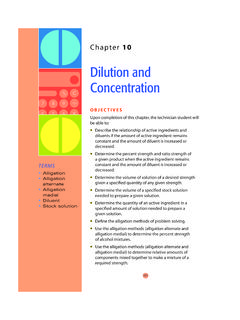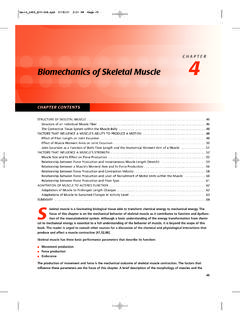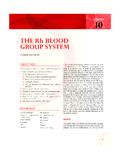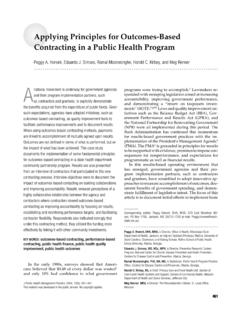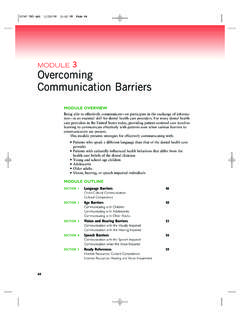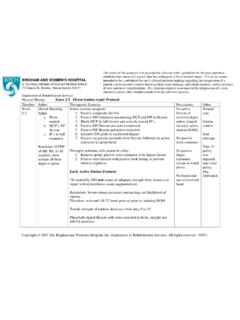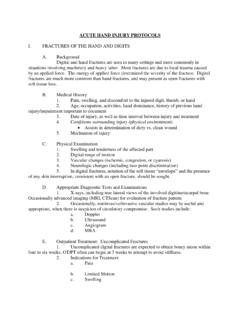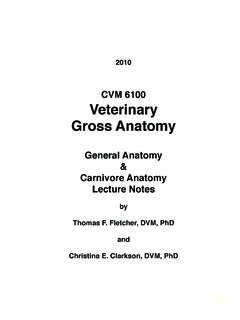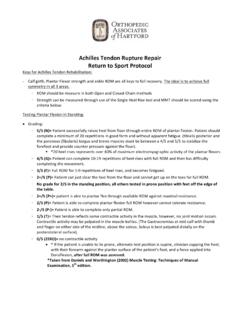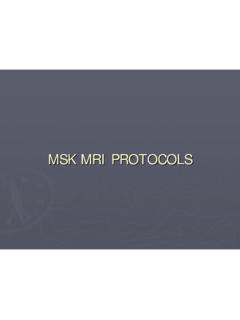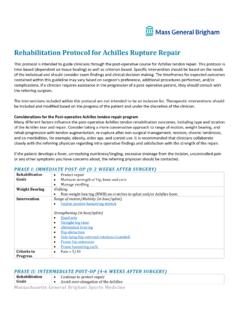Transcription of Lower Limb - Lippincott Williams & Wilkins
1 Overview of the RegionBONES AND BONE MARKINGSOF THE REGION Pelvic GirdleFemur PatellaTibia and FibulaBones of the FootJOINTS, LIGAMENTS, ANDBURSAE OF THE REGIONS acroiliac JointHip JointKnee JointTibiofibular JointsAnkle JointsJoints That Permit Inversion and EversionRemaining Joints Within the FootCONNECTIVE TISSUESTRUCTURES OF THE REGIONDeep Investing Fascia and Iliotibial BandFascial Compartment Divisions in the LegPlantar Fascia or AponeurosisIndividual MusclesHip Joint MusclesPIRIFORMIS AND THE OTHERDEEP LATERAL ROTATORS OFTHE HIPADDUCTOR MAGNUSADDUCTOR LONGUS AND BREVISPECTINEUSGRACILISGLUTEUS MINIMUS GLUTEUS MEDIUSTENSOR FASCIA LATAEGLUTEUS
2 MAXIMUSHAMSTRINGS:SEMIMEMBRANOSUSHAMSTRI NGS:SEMITENDINOSUSHAMSTRINGS: BICEPSFEMORISILIOPSOAS (PSOAS MAJOR ANDILIACUS)QUADRICEPS GROUP: VASTUSINTERMEDIUSQUADRICEPS GROUP: VASTUSMEDIALISQUADRICEPS GROUP: VASTUSLATERALISQUADRICEPS GROUP: RECTUSFEMORISSARTORIUSR egional Illustrations of MusclesPosterior Knee and Superficial Posterior Leg MusclesPOPLITEUSPLANTARISGASTROCNEMIUSSO LEUSM uscles of the Leg That Movethe Foot and ToesTIBIALIS POSTERIORFLEXOR DIGITORUM LONGUSFLEXOR HALLUCIS LONGUSPERONEUS LONGUSPERONEUS BREVISPERONEUS TERTIUSEXTENSOR DIGITORUM LONGUSEXTENSOR HALLUCIS LONGUS CHAPTER OUTLINEL ower Limb5(Continued)297 LWBK788-Ch5_297-437_Moorecraft Edition 1 24/01/11 9.
3 24 PM Page 297298 PART 2 INDIVIDUAL MUSCLES BY BODY REGIONOVERVIEW OF THE REGIONThe Lower limb is designed for weight-bearing, balance, andmobility. The bones and muscles of the Lower limb are largerand stronger than those of the upper limb, which is necessaryfor the functions of weight-bearing and balance. Our lowerlimbs carry us, allow us to push forward, and also keep usstanding still. Our sense of steadiness and strength oftencomes from our Lower limbs. The muscles of the thigh are thick and strong and can tol-erate greater pressure during massage than the smaller mus-cles of the arm.
4 P trissage is generally welcome and easy toperform in the thigh. The muscles of the posterior leg arealso thick and strong, as they propel us forward. The ante-rior leg is less muscular and more suited to friction or deepeffleurage. The foot is our anchor, grounding us to the earth. Althoughcomposed of a complex structure of bones, joints, and mus-cles, the foot is also our steady connection to the AND BONE MARKINGS OF THE REGIONThe bones of the Lower limb include the pelvic girdle, femur,patella, tibia, fibula, and bones of the foot.
5 These are dis-cussed GirdleThe pelvic girdle contains the hip bone and the sacrum. As al-ready noted, the hip bone contains the ilium, ischium, andpubis (see Chapter 4). Recall that the iliac crest contains theanterior superior iliac spine (ASIS) and the posterior supe-rior iliac spine (PSIS). The iliac spine contains the entire iliaccrest and extends inferiorly in the front and back to includethe anterior inferior iliac spine (AIIS) and posterior inferioriliac spine (PIIS), as well. The anterior aspect of the ilium isbroad and curved, like a fossa.
6 It is called the iliac fossa. Recall that the ischium has a significant bone marking inthe ischial tuberosity. The hamstring muscles connect to the -ischial tuberosity. In addition, the ischium contains a spine,which separates the greater sciatic notch from the lesser that the pubis contains two rami, the superiorpubic ramus and the inferior pubic ramus. The thigh adduc-tors originate on the that the acetabulum is the name of the socket thatarticulates with the head of the femur to form the hip acetabulum is where the ilium, ischium, and pubis jointogether.
7 Figure 5-1 shows bones and bone markings of femur, or thigh bone, is the longest and strongest bonein the body. Its rounded head, located on the proximal, me-dial aspect of the femur, fits beautifully in the acetabulum toform the hip joint. The greater trochanter is a sizable bonemarking on the lateral aspect of the proximal femur. Thelesser trochanter is smaller and is located distal and slightlyposterior to the head of the femur on the medial aspect of thebone. Rounded medial and lateral condyles are located onthe distal end of the femur and articulate with the tibia.
8 Arough line called the linea asperaruns almost the full lengthof the posterior femur. The gluteal tuberosity is located onthe proximal, posterior femur, very close to the proximal lineaaspera. The pectineal line is located proximal and medial onthe posterior femur, just inferior to the lesser 5-2 illustrates the femur and its bone markings, as wellas the patella. PatellaThe patella or knee cap is a sesamoid bone that lies anteriorto the junction of the femur and tibia. The patella is cartilagi-nous at birth and ossifies between 3 and 6 years of age.
9 Thepatella is embedded in the quadriceps tendon and causesthe tendon to be positioned more anteriorly, thus enhanc-ing the leverage of the quadriceps tendon as it pulls on thetibial tuberosity to extend the knee. The patella slides up andTIBIALIS ANTERIORR egional Illustrations of MusclesIntrinsic Foot MusclesDORSAL INTEROSSEIPLANTAR INTEROSSEILAYER 3 INTRINSIC FOOTMUSCLESFLEXOR HALLUCIS BREVISADDUCTOR HALLUCISFLEXOR DIGITI MINIMI BREVISLUMBRICALSQUADRATUS PLANTAEABDUCTOR HALLUCISFLEXOR DIGITORUM BREVISABDUCTOR DIGITI MINIMIR egional Illustrations of MusclesILLUSTRATIONS OF NERVESUPPLY AND ARTERIAL SUPPLYTO Lower LIMBC hapter SummaryWorkbook Muscle Drawing ExercisesPalpation ExercisesClay Work ExercisesCase Study ExercisesReview
10 ExercisesLWBK788-Ch5_297-438:Moorecraft Edition 1 1/29/11 4:27 PM Page 298down as we flex and extend the leg. Cartilage on the poste-rior aspect of the patella provides cushioning between thepatella and the femur (see Fig. 5-2).Tibia and FibulaThe tibia and fibula are the bones of the leg. The tibia ismuch the larger and is located medial to the fibula. The tibiais the weight-bearing bone and is part of the knee joint. Sev-eral important bone markings exist on the tibia and proximal end of the tibia contains two condyles, a me-dial condyle and a lateral condyle.
